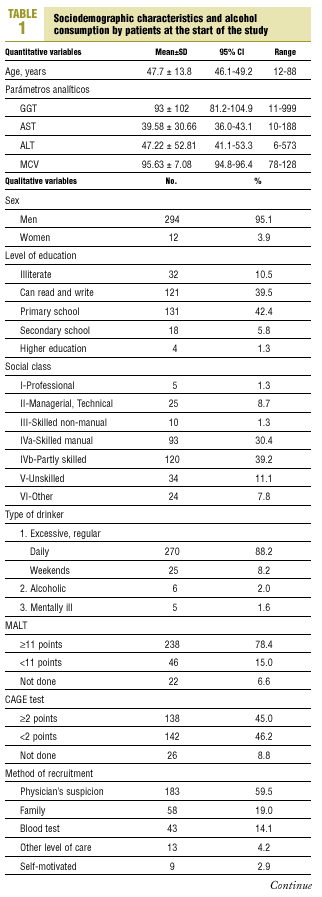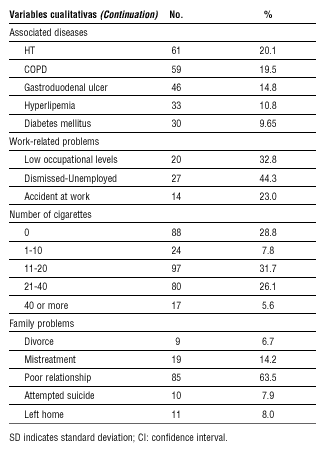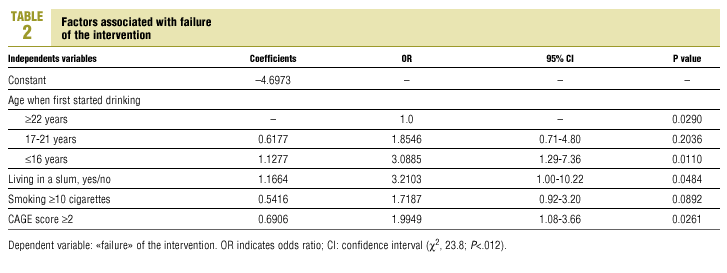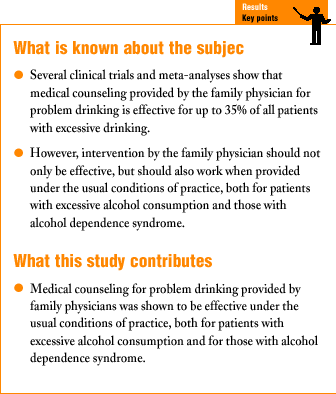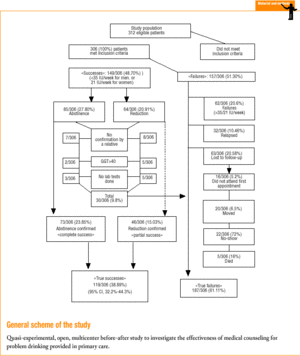1 year and 2 years later. Main measures. The response variable was self-reported alcohol consumption together with normal GGT values or confirmation of alcohol consumption by a relative. The results were subjected to intention-to-treat analysis. Results. Of the 306 patients included in the study, 95.1% were men and 78.4% had ADS. After 2 years 38.89% (95% CI, 32.2%-44.3%) had attained their treatment goal: 23.85% were in complete abstinence, and 15.0% consumed moderate amounts of alcohol below the limit considered to indicate risk. Starting excessive consumption at less than 16 years of age (odds ratio [OR], 3.0885), living in a slum (OR, 3.2103), smoking (OR, 1.7187), and a positive CAGE test (OR, 1.9949) were associated with failure of the intervention ( P<.05). Conclusions. Counseling provided by the family doctor was highly effective under the usual conditions of general practice, both for patients with excessive alcohol consumption and for patients with con ADS.
Introduction
In Spain, approximately four million persons consume excessive amounts of alcohol, and almost two million meet the criteria for alcohol dependence.1 Excessive alcohol consumption is accompanied by a number of serious health and social problems,2,3 and by an increase in the use of health services, especially at the primary care level,1,4,5 It is estimated that 15%-20% of all visits to family physicians are attributable to alcohol and other drugs.6
The role of the family physician in caring for this type of patient is considered crucial because of the high prevalence of this problem, its high rate of recurrence within families, the close contact of family doctors with their patients. Moreover, the fact that many patients are more willing to accept primary care interventions than treatment at higher levels of care.7-9 The practitioner´s role is mainly in early diagnosis (active searching for cases) and interventions by educational counseling aimed at modifying drinking patterns.6 The effectiveness of such intervention has been evaluated in several studies in Spain and other countries, which have shown, in general, that persons with excessive alcohol consumption can reduce their drinking by 35% after receiving brief counseling from their physician.10-26 However, most of these studies were markedly experimental in nature, with restrictive inclusion criteria and failure to reproduce the usual conditions of general practice. To determine the true effectiveness of this type of intervention, it is necessary to determine which factors influence the prognosis, their impact on significant clinical variables such as mortality and morbidity, and their effects on health service utilization. Although some of these influences have been studied, the evidence has not been robustly demonstrated to be strong, and additional studies designed specifically to investigate these factors are needed.13,14,22
An important first step toward evaluating the impact of intervention by the family physician is to determine whether such intervention is effective not only in itself, but when results obtained under the usual working conditions of primary care are evaluated. The clinical trial model, with its traditionally explanatory focus, does not appear to be a suitable approach, and a more pragmatic design is needed (as in naturalistic studies).27-29 Finding such a approach was the first aim of the present study. A second aim was to identify characteristics or conditioning factors in patients for whom medical counseling less likely to succeed, in order to deal with these factors to the extent this was possible.
Material and methods
Study population
This quasi-experimental, open, multicenter before-after study was designed to evaluate the effectiveness of a specific intervention (family physician´s advice for problem drinking).
The study population consisted of patients with alcohol dependence syndrome (ADS) or excessive drinking, who were identified by their family physician in 14 practices (7 rural, 7 urban) at 7 health centers located in the province of Córdoba (Southern Spain)
Consecutive sampling was used to include in the study all patients of either sex, aged 10 years or more, who drank more than 35 IU/week (boys and men) or more than 21 IU/week (girls and women) (1 IU=8 g alcohol), or who met the criteria for ADS as diagnosed from a score of 11 or higher on the MALT questionnaire.30,31 We excluded patients who were being treated by specialists or who had serious organic processes (AIDS, advanced liver disease, heroin or cocaine addiction, cancer, psychotic disorder or any disorder with severe cognitive impairment).
Sample size was calculated with self-reported alcohol consumption as the main evaluation criterion. We aimed to detect a minimum clinically relevant difference of 10% between the percentage of patients who were drinkers before (pbefore=100%) and after (pafter=90%) the intervention. For an alpha error of 5%, a statistical power of 90% (beta error=0.10), and a bilateral hypothesis, the minimum sample size necessary was estimated as 98 subjects. We assumed a drop-out rate of 65% by the end of the study, so that with the formula Na=N×1(1-R),32 where R is the percentage of expected drop-outs (=35%), the minimum number of subjects needed at the start of the study was estimated as 150. For practical reasons, and to increase precision, we decided to recruit a total of 306 patients.
Method
The main study factor was medical counseling, and the main outcome variable was alcohol consumption. The results of treatment were classified as «complete success» (abstinence) or «partial success» (effective reduction in intake). For a case to be considered a complete success the patient had to remain in complete abstinence (self-reported) for a period longer than 3 months, and abstinence had to be confirmed by a first-degree relative or by a GGT value below the 95th percentile of normality according to accepted limits (45 U/L). A case was considered a partial success when alcohol consumption decreased to below the limits considered to indicate risk (<35 IU/week in men, 21 IU/week in women) and the decrease was maintained for a period longer than 3 months. Other variables considered in this study were age, place of residence (rural, urban, or slum), social class (based on the classification proposed by Alonso et al33), age when drinking first started, type of drinker (according to the classification of Alonso-Fernández34), score on the CAGE test for the detection of alcohol abuse (this questionnaire is recommended as a complement to the interview aimed at quantifying consumption6), alcohol consumption at the start of the study, familial antecedents of alcoholism, family or work-related problems related with alcohol, values of GGT, AST, ALT and MCV, and smoking habit.
Interventions and follow-up
Participating physicians were trained in six 2-hour workshops that included discussion of cases and consensus on procedures and teaching materials. A common intervention program, involving adaptation of the usual practices of family physicians at all participating health centers, was developed by consensus. The intervention began by identifying and recruiting patients who visited the health center with a case finding strategy.6 Informed consent was requested from each patient, and then brief (3-5 min) counseling was provided. During the first month, in the course of a visit lasting approximately 20 min, the MALT questionnaire was completed, and information was recorded on a data collection sheet from a complete clinical work-up that included information on the degree of impairment and psychological, social and family support. During this interview the physician offered the patient continuing care, and if the patient declined, the physician noted his or her willingness to see the patient again whenever the patient wished. This was followed by from one to three short follow-up visits (no longer than 15 min) depending on the patient, and three further follow-up visits were scheduled at 3, 12 and 24 months to evaluate the patient´s status and serve as a back-up to the initial intervention. Each of these three interventions lasted 65 to 75 min. All patients were followed for 2 years from recruitment in December 1997.
Statistical analysis
Intention-to-treat analysis was used, and all patients included in the study were evaluated regardless of whether they completed the follow-up period or dropped out early, and regardless of whether they attended the first scheduled visit. Drop-outs on the first visit and on subsequent visits, and patients who were withdrawn from the study, were considered cases in which the intervention failed.
Data collection notebooks were checked and purged of errors before they were examined by a researcher who was unaware of the recruitment and intervention processes. Descriptive statistics were used, and bivariate analysis was done with the chi-squared test, McNemar's test, Student´t t test and analysis of variance (ANOVA) for repeated measures (P<.05). To try to identify the factors that predicted failure of the intervention, we used a backward stepwise unconditional multiple logistic regression strategy and a mixed model that included the following independent variables: age at the start of excessive alcohol consumption, GAGE and MALT scores, smoking habit, place of residence, familial antecedents of alcoholism, family or work problems related with alcohol consumption, and GGT value at the start of the study. The most parsimonious model was chosen on the basis of the likelihood ratio test, and the statistical criterion for excluding a given variable from the model was set at P<.01. All data were analyzed with the SPSS program (version 6.0.1) for Windows (SPSS Inc., Chicago 1994).
Results
A total of 306 persons were included. The sociodemographic characteristics and levels of alcohol consumption are shown in table 1. Males predominated the sample (95.1%), and mean age was 47.7 years.
The rate of true successes varied between participating physicians, ranging from 33.3% to 49.4%. Among patients with ADS (72%), the proportion in complete abstinence at the end of the study was 25%, and the proportion who had effectively reduced alcohol consumption was 17%. Of all confirmed successes, 4.9% (15 patients) were referred to specialists because of the seriousness of their condition (7 in the group of abstainers and 8 in the group of patients who achieved an effective reduction in intake). Of the total, 2.6% were judged by the physician researcher to need specialized care, but the patients declined this option and preferred to be seen by their primary care doctor. After 3 months, 16.9% of the patients failed to attend the first scheduled follow-up visit; after 12 months this figure decreased to 7.9%, and after 24 months, to 5.2%.
To track changes in status during follow-up of patients who were abstinent or who had reduced their intake, we compared the results after 3 months with those obtained after 12 and 24 months. Significant differences were found when we compared the status at 3 months with that at 12 or 24 months (P<.05), but the differences between 12 and 24 months were not significant (P=.519). Therefore patients who were abstinent or who had reduced their drinking after 1 year of follow-up had no change in status at the end of the study period.
Table 2 shows the variables that were independently associated with failure of the intervention. This model explained 70% of the change in the outcome variable (χ2, 23.8; P<.012).
Discussion
Several previous, well-designed clinical trials documented the efficacy of family physician intervention for reducing alcohol intake in patients with excessive consumption.10-26 A meta-analysis of the results for 3946 patients who participated in 12 clinical trials noted that the intervention was twice as effective as the placebo,12 and subsequent studies provided similar results.11,22 In the most relevant trials, which used criteria for effective reduction of intake and abstinence similar to those in the present study,16-18,20,21,23,25 success rates ranged from 15% to 43%.
The present study shows that counseling for alcohol consumption, provided by the primary care physician under the usual conditions of practice, is effective for 4 out of every 10 patients after a 2-year follow-up period. This makes our results similar to the best success rates in trials carried out under ideal conditions. However, certain characteristics of these earlier studies affect their external validity. For example, not all studies were done in a purely primary care setting.13-17 Some studies excluded persons who consumed more than 131 IU/week (men) or 87 IU/week (women) (Oxford Study),21 more than 105/70 IU (WHO study),16 or more than 50 IU (Wisconsin study).22 Other patients were excluded because of elevated GGT14,15 or AIDS.11,13-21,23-26 In the present study, mean weekly intake in patients eligible for the intervention was 101 IU, or 808 g/week, i.e., almost double that used for patients included in other experimental studies of efficacy.11,16-18,20-22,25,26 With regard to treatment for alcoholism, not considering these patients would lead to the exclusion of many (78.4% in our study) who seek primary care and who also have the most serious problems. It is estimated that 50% of the 4 million persons who are excessive drinkers are also alcoholic.1 Our study shows that effective intervention provided by the family physician can help these patients too, just as it can help excessive drinkers.
When the actual impact of a health program or intervention is evaluated, the analysis should include all subjects initially recruited, whether they benefited or not from the intervention, i.e., drop-outs and withdrawals during follow-up. In other words, researchers should place themselves in «the worst possible position in the face of an alternative hypothesis», and use one of the strategies involved in intention-to-treat analysis.32 This conservative approach was used to analyze the present results. Studies done to date with intention-to-treat analysis have included only those patients who attended the first scheduled appointment, i.e., 47% to 61% of all cases.18,20,21,25 This implies patient selection bias and camouflages the actual clinical situation. For example, in one of the best-designed studies published to date, Wallace et al.18 noted that because more older persons, women and men who drank less attended the appointments, the effect of the intervention was probably overestimated.
We therefore believe that the main contribution of the present study is the fact that it was designed as a naturalistic, pragmatic «effectiveness trial» in a prospective cohort that was followed and evaluated for a relatively long period (2 years). This approach goes further than previously published studies of the effectiveness of a given intervention.25,30
Some strengths and weaknesses of the present study are worth noting. The method can be considered appropriate for several reasons:
1. Available evidence on the effectiveness of counseling for alcohol consumption suggests that it would be unethical to undertake a study with a control group for which no intervention was used.
2. Confirmation by a relative of the patient´s self-reported consumption has been recommended by others.12,22 In addition, we recorded GGT, the most sensitive and specific biological marker for alcohol abuse in primary care.6
3. A minimum of 3 months of abstinence as a condition for considering the intervention to be effective is felt to be a more accurate criterion than shorter periods. When drinking during the week prior to the appointment is recorded,11,15-26 the patients may intentionally reduce their consumption because they know they will be asked how much they drank during this period.12.
4. Although one of the features of primary care is its continuity, most studies we reviewed (except for one19) used follow-up periods of 1 year or less. Although a 2-year follow-up period seems more realistic, our results show that most patients who had quit drinking or who reduced their intake after 1 year remained abstemious or drank less after 2 years.
Although we have no data on how patients who quit drinking after a primary care intervention fared after longer periods of follow-up, it should be recalled that the relapse rate, especially among patients with ADS, is usually high. Studies with longer follow-up periods are therefore advisable.
It may be useful for family physicians to know which factors condition or predict failure of interventions to reduce drinking, so that these factors can be taken into account when individual care strategies are developed. The limited success of interventions aimed at problem drinking when other social addictions such as smoking are present has been reported by others.10,22 This should be taken into account when the best approach and the best moment are being chosen to suggest to the patient that he or she should also consider quitting smoking. In addition, unfavorable socioeconomic conditions diminish the effectiveness of medical counseling; this has generally been related to the presence of other social and health problems that are seen as more real, more threatening and of greater priority for the population.35 These factors are a reminder of the limitations to the physician´s role, and of the need to give priority to multidisciplinary community-level interventions aimed at general social and health problems. Current findings emphasize the importance of interventions aimed at the very young, especially in Spain, where the figures regarding excess consumption by this age group are alarming.36-38 Early initiation in drinking is also a factor that needs to be considered, as it can be expected to reduce the effectiveness of medical interventions, and it is associated with more alcohol-related problems in these persons than in persons who begin to drink or smoke at an older age.39
The fact that the CAGE results predicted failures better than did the MALT may have been due to the latter´s greater sensitivity in detecting excessive drinkers.31 False negative rates of up to 50% have been reported for the detection of excessive drinkers with the CAGE,40 which detects only intake levels greater than 70 IU/week.40,41
The definition of ADS is broad, and our results suggest: a) that there is a gradient in the degree of dependence, and b) that the success or failure of primary care intervention depends on how severe the degree of dependence is. If we exclude patients with severe withdrawal syndrome, earlier attempts at abstinence that failed, and severe psychiatric or social problems, referral of these patients to specialized care should be considered only after an overall evaluation that takes into account the presence of factors such as early age at first drink, smoking, low or very low socioeconomic level, and severe ADS as shown by a positive CAGE score.
Correspondence: Roger Ruiz Moral. Unidad Docente de Medicina de Familia. C/ Dr Blanco Soler, 4. 14004 Córdoba. España. E-mail: med021013@nacom.es
This study was financed by the Health Research Funds (project no. FIS 95/0623) and by the Health Council of the Andalusian Regional Government (project no. 94/498-82).
1Members of the Grupo Cordobés de Investigación en Atención Primaria (GCIAP): J.A. Fernández García, R. Ruiz Moral, L. Pérula de Torres,
L. Campos Sánchez,N. Lora Cerezo, J. Martínez de la Iglesia, J. Fonseca del Pozo, J.J. García Gallego, M. Muñoz Alamo, C. Aguado Taberné, A. Yun Casalilla, B. Ranz Garijo, J. Espejo Espejo, M.J. Fernández Fernández, J.M. Bueno Cobo, J. Almazán Rubio, S. Gascón Veguine and R. Santos Godoy
Manuscript received 6 May 2002.
Manuscript accepted for publication 8 July 2002.








